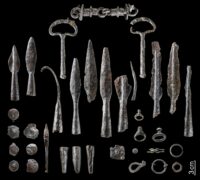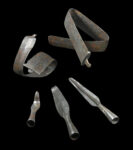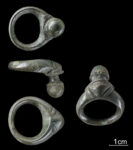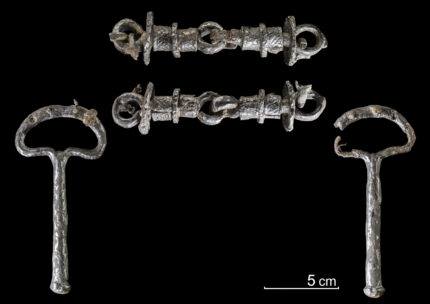 Archaeologists working with a local historian and metal detectorists have discovered an Iron Age weapons deposit that is the largest ever found in the northwestern German state of North Rhine-Westphalia. Between 2018 and 2020, volunteers coordinated with archaeologists from the Regional Association of Westphalia-Lippe (LWL) to scan the top of the Wilzenberg mountain in the hilly Sauerland region. In three seasons, the survey recovered more than 150 metal weapons, armour and horse fittings from the pre-Roman Iron Age. Most of the objects date to around 300 B.C. through the 1st century B.C., with the coins and blades dating to the later part of the range.
Archaeologists working with a local historian and metal detectorists have discovered an Iron Age weapons deposit that is the largest ever found in the northwestern German state of North Rhine-Westphalia. Between 2018 and 2020, volunteers coordinated with archaeologists from the Regional Association of Westphalia-Lippe (LWL) to scan the top of the Wilzenberg mountain in the hilly Sauerland region. In three seasons, the survey recovered more than 150 metal weapons, armour and horse fittings from the pre-Roman Iron Age. Most of the objects date to around 300 B.C. through the 1st century B.C., with the coins and blades dating to the later part of the range.
 The Wilzenberg, a mountain 658 meters (2159 feet) high, stands out on a ridge of smaller forested hills in what is now the Sauerland-Rothaargebirge nature park. Known as the Holy Mountain of the Sauerland, the geographic singularity has been held in reverence at least since the 3rd century B.C. At the summit is the Wallburg, the remains of a hill fort built in the 3rd-2nd century B.C. from wood, stone and earth. Christian worshipers added a second circular structure in the 9th or 10th century. A chapel was documented at the site in 1543 when it was already a site of pilgrimage. The last hermit to renounce the world and choose an ascetic life atop the Wilzenberg only died around 1850, and pilgrims still flock to the mountain for processions on Ascension Day (39 days after Easter) and Trinity Day (first Sunday after Pentecost, May 30th this year).
The Wilzenberg, a mountain 658 meters (2159 feet) high, stands out on a ridge of smaller forested hills in what is now the Sauerland-Rothaargebirge nature park. Known as the Holy Mountain of the Sauerland, the geographic singularity has been held in reverence at least since the 3rd century B.C. At the summit is the Wallburg, the remains of a hill fort built in the 3rd-2nd century B.C. from wood, stone and earth. Christian worshipers added a second circular structure in the 9th or 10th century. A chapel was documented at the site in 1543 when it was already a site of pilgrimage. The last hermit to renounce the world and choose an ascetic life atop the Wilzenberg only died around 1850, and pilgrims still flock to the mountain for processions on Ascension Day (39 days after Easter) and Trinity Day (first Sunday after Pentecost, May 30th this year).
 In 1950, a small cache of three spear tips was discovered wrapped by two swords that had been deliberately coiled around the points. Among the recent discoveries are around 40 spear tips. There are also fragments of shield bosses, belt hooks, tools, a fibula, three silver coins and an extremely rare horse bridle that has handles at the bit. These were likely used for horses that were pulling chariots; the handles allowed for precision steering necessary in the heat of battle.
In 1950, a small cache of three spear tips was discovered wrapped by two swords that had been deliberately coiled around the points. Among the recent discoveries are around 40 spear tips. There are also fragments of shield bosses, belt hooks, tools, a fibula, three silver coins and an extremely rare horse bridle that has handles at the bit. These were likely used for horses that were pulling chariots; the handles allowed for precision steering necessary in the heat of battle.
But there was no battle on the Wilzenberg, or at least no archaeological evidence of a violent clash has ever been recorded. The damage to the  weapons and armature was not inflicted in a war. The tips of spears and lances were blunted, the iron bosses broken off the shields and left in place. A few pieces were buried, but most of them simply subsided into the ground. It’s not clear whether they were scattered on the mountaintop in a single event or over time.
weapons and armature was not inflicted in a war. The tips of spears and lances were blunted, the iron bosses broken off the shields and left in place. A few pieces were buried, but most of them simply subsided into the ground. It’s not clear whether they were scattered on the mountaintop in a single event or over time.
“According to current research, it is conceivable that a fight took place in the area around Wilzenberg and that the winners completed their triumph by bringing the captured weapons, belts and harnesses to the Wallburg”, explains LWL archaeologist Dr. Manuel Zeiler. The winners apparently willfully damaged many of the pieces before they were then put on display on the Wilzenberg and left to their own devices. These assumptions are based on the results of French research, which shows that such cult acts in Iron Age Europe took place primarily in the Celtic culture and on its periphery. Weapons of inferior opponents were ritually destroyed; these actions were usually preceded by a battle. […]
Especially in the last centuries BC In the area between France in the west and Slovakia in the east, such weapons depots were set up again and again. Now the hoard find from Wilzenberg in the Sauerland can possibly close research gaps.
